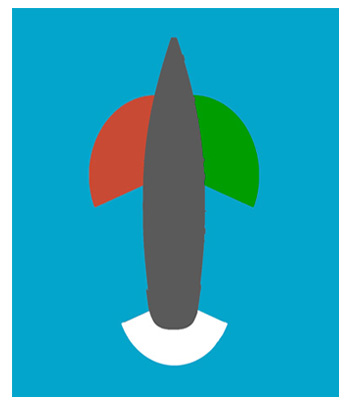What we have seen teaching vessel lights over many years is that those learning the vessel lights tend to try to learn the lights off by heart rather than trying to make life easier – and more accurate – by developing a method to be able to identify vessels and what they are ‘doing’.
Like anything the method we will introduce doesn’t work 100% of the time and you still need to learn some of the lights – mainly the ‘doing’ lights – but what having the ‘method’ does is give you brain space to be able to identify vessels more easily and so to be able to take the action you need to when afloat.
It all starts with understanding what you will ‘see’ when looking at the two base types of craft – ‘a power-driven’ vessel and a ‘sailing vessel’.
Power-driven vessel
Let’s look at the power driven vessel first.
Keeping it simple what you see is the red and green navigation lights. These are obviously only visible from the side that you are looking at and are not visible from the stern.
You then have the white light. This is visible the whole way round the vessel. So think about what you see if looking at the vessel as you circle it. Port side you will see a white above a red, starboard side a white above green and from the stern just a white. On power-driven vessels below 12m the stern light can be combined with the ‘masthead’ light into a single allround white – almost all ‘powerboat scheme’ type vessels will be set up like this.
Power-driven vessels above 50m must have a second white masthead light. Vessels below 50m can if they wish.
And that basically is it for power-driven vessels. Walk yourself around the image on screen and visualise what the power-driven vessel will look like.
Sailing vessel
So what’s different for the sailing vessel? In short not much but it makes a big difference to what you see.
The white masthead light isn’t there and all you have is the red, green and sternlight. You cannot tell the size of the sailing vessel from its lights.
On top of these navigation lights a power-driven vessel then might be doing something. These ‘doing’ lights are in addition to the navigation lights.
So what’s the ‘method’?
Treat it as a three stage process;
- What is the vessel, how big is it etc?
- What (if anything) is it doing?
- Aspect?
- Does what it is doing affect whether it is ‘underway’ and so it can be said to be ‘making way’?
The ‘method’ is all about asking yourself some questions
???? Is it a power-driven or a sailing vessel?
???? What size is it? – if we can tell
???? What aspect are we looking at – and perhaps which direction does that mean it may be moving?
!!!! Underway!
Note the fourth point is a statement. Navigation lights only tell us the vessel is underway (not tethered to the earth via mooring lines or an anchor) and cannot tell us its propelling itself (making way).
Then ask what the vessel is doing.
If the vessel is doing one of the following:
- Restricted in ability to manoeuvre (‘RAM’)
- Not under command (‘NUC’)
- Fishing or trawling
Then any of these three plus the nav lights mean the vessel is ‘making way’.
If the doing lights are not one of the above then all you can still tell is that its underway.
So now try the quiz and apply this method to the quiz….. good luck!



